Wednesday
It was my first GDC. Spoiler: I enjoyed it. It was an amazing experience, although it was a bit overwhelming at times. As I meandered around, perusing the wonders on display, I took some photos and some notes, which form the basis for this narrative.
Many interviews and news articles come out of every GDC, but not many accountings come from within the trenches, so to speak. My hope is to convey a sense of how it feels to be wandering around without much in the way of a schedule, just checking out the things that strike your fancy (assuming you have an interest in indie, weird, and retro games—and that you have an all-access pass, of course).
This is the first of three installments, one for each day I was there.
New Arrivals
I landed in San Francisco early Wednesday morning, the first day of the expo proper, and took an Uber to the Moscone Center. The immense convention center is divided into two hulking buildings, Moscone North and South. They are separated aboveground by Howard Street, but come together underneath Howard and the Yerba Buena Gardens to form a massive, carpeted cavern. There is also a third, smaller building called Moscone West that sits across 4th Street from Moscone North.
I looked around me to take it all in, the size of the buildings and the sea of people—cool people—milling about or walking between the buildings. I was here.
There was a palpable sense of potential energy gathering in the air. Lives were going to be changed here; doors would be opened, destinies charted, and ships set on their courses.
I headed into the North Hall and found my way down to the mezzanine level, where the press lounge was located. The yellow-shirted volunteers there, as well as everywhere else I encountered any, were exceptionally friendly and helpful. I picked up my badge, with its shiny red ribbon labeled “Media”, and headed back out into the crowd.
{% pullquote Hello, GDC! %}
As I descended the lengthy escalator to the lower level, a wave of anxiety entwined with awe washed over me. I knew it was going to be easy to become overwhelmed by the vast amount of potential things to see, so I resolved to concentrate my efforts on the areas that held the most interest for me.
I strode past the Microsoft Pavilion, glancing at screens displaying impeccable hi-res graphics. I made my way down a long aisle of booths populated by companies that offered various ways to monetize mobile games. Even after reading their descriptive placards, I wasn’t sure what some of them did. I passed by walled enclosures set up by the likes of Oculus and Valve. I actually stopped by the Valve fortress, but they were only showing their wares by appointment, and all the slots had already been booked.
The IGF Pavilion
Finally, I found what I was looking for: the IGF (Independent Games Festival) Pavilion. I ended up spending the rest of the afternoon there.
{% pullquote The IGF Pavilion %}
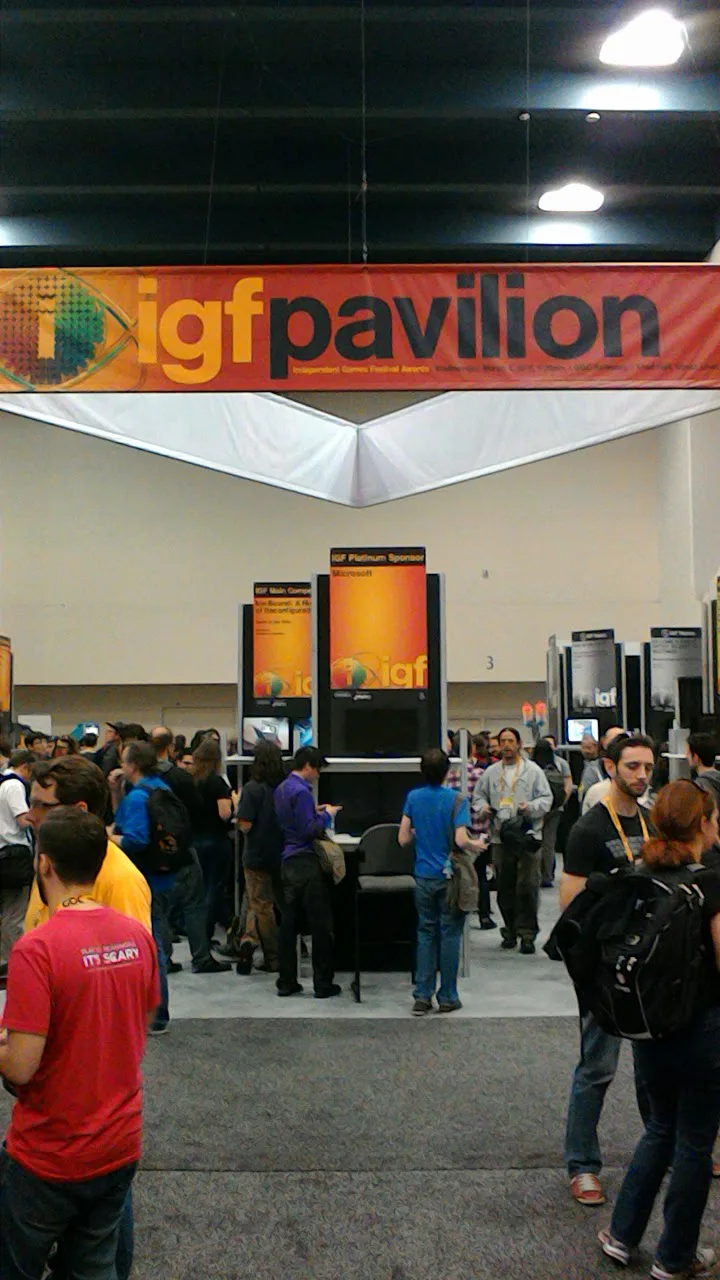
It was a fairly large, square-shaped area that was bisected and bordered by double rows of booths. Each booth was home to one of the finalist games in the IGF Awards, which were scheduled to be given out later that night. Some booths were staffed by game developers, others were unattended at the time, but no game went unplayed for long. It felt like being in an arcade full of indie games, many of which were being shown off by their creators. I played a bunch of games, all of them good, but I’ve chosen a few highlights…
{% pullquote Downwell at the IGF Pavilion %}
One new game which immediately caught my attention was Downwell, the creation of Tokyo University of the Arts student Ojiro Fumoto. The tri-colored action game was a finalist for the IGF Student Award, and it’s already turned enough heads in the right places to have been picked up by Devolver Digital for publishing.
{% pullquote This writer playing This War of Mine at the IGF Pavilion %}
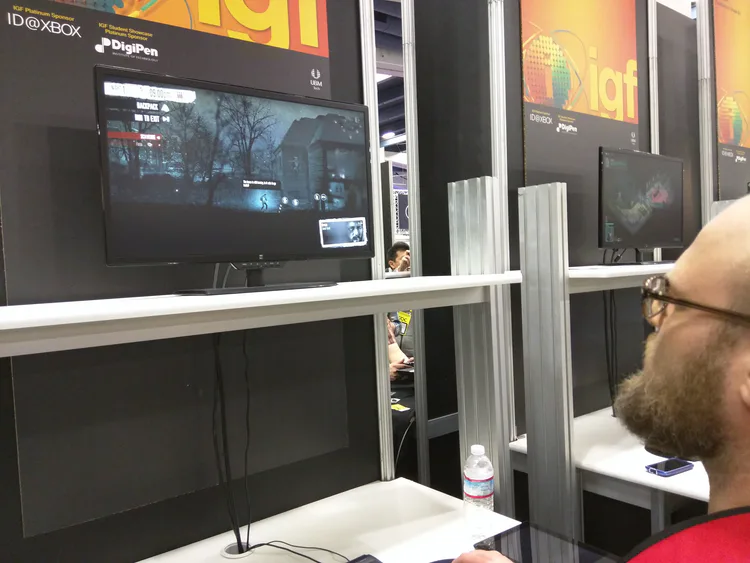
Another game that stood out to me is This War of Mine, which was nominated for both the Seumas McNally Grand Prize and for Excellence in Narrative, and which has won quite a bit of acclaim in the press. It’s an incredibly bleak, beautifully presented game about doing morally questionable things to survive wartime. Sometimes it feels like a point’n’click adventure; at other times it feels like playing The Sims (if your sims could kill and steal food from each other).
Rooftop Cop is an odd beast, and one I like very much. Here’s a project that’s hard to get a sense of from just a snippet of gameplay. The trailer does somewhat of a better job because it at least shows you some of the thing’s different components. A finalist for the IGF Student Award, Rooftop Cop was originally developer Stephen Lawrence Clark’s MFA thesis for NYU’s Tisch School of the Arts. It’s done well since then, especially for such an experimental game, and it has even recently been released on Steam. Clark describes it as “a collection of five endless vignette games, and companion 7-track album”. I’ll add that each of the small games challenges standard videogame concepts like authority and goals while still being interesting to play, and any randomly chosen screenshot is a framable example of good visual design. So if you’re into art games and/or digital art, this is a must-buy.
{% pullquote Rooftop Cop trailer %}
I had fun playing, and watching people’s reactions as they played, a couple of Nuovo Award finalists. Nina Freeman’s charming, funny how do you Do It? is about a little girl using dolls to try and understand sex before her mom gets home. Etter Studio’s Plug & Play involves a group of humanoids who have either a plug or a socket for a head; they interact with each other in just about every way you can imagine.
{% pullquote Plug and Play at the IGF Pavilion %}
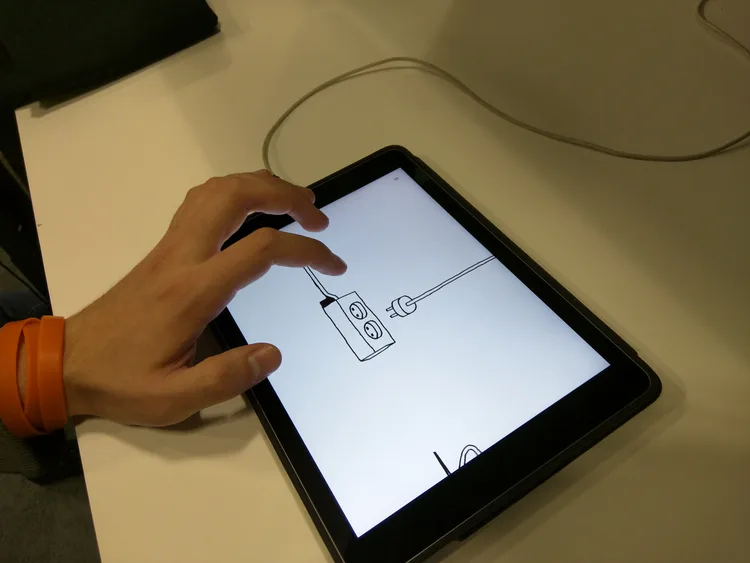
At one point, I rounded a corner and there was Justin Smith of Captain Games sitting next to the Desert Golfing booth. The infinite physics masterpiece was a finalist for the Nuovo Award (though I think it should have been up for Excellence in Design, as well). I’ve played the hell out of this game and in fact had it installed on the very tablet I was carrying. In addition, I’ve been a fan of Justin’s many memorable game jam games as well as his mobile releases (some of his jam games actually served as prototypes of later commercial games such as No Brakes Valet, So Long, Oregon!, and Enviro-Bear 2010)… So I fairly clammed up and had what was my first—but not last—experience at the conference of feeling like an incoherent fanboy.
{% pullquote Desert Golfing at the IGF Pavilion %}
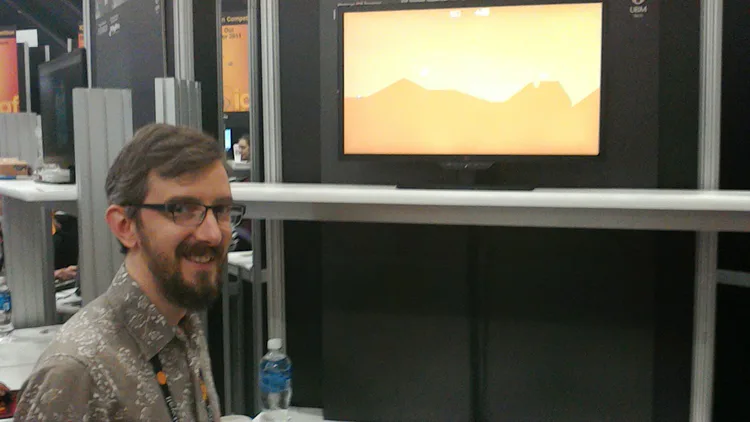
I conveyed my admiration and managed to ask him to pose with his game for a photo. I also was able to form enough words to ask him something about how the levels were generated in the game and whether they were procedural or random. He asked me, rhetorically, if there was a difference. He did tell me that his method was a lot simpler than most people seemed to think it was. I also asked if he had fussed a lot over the friction of the sand and the weight of the ball, because it felt so perfect and honed to me. He told me plainly that he had been making physics games for a long time and had kind of developed a feel for them, and that things pretty much fell into place with Desert Golfing. Once again, it had been easier than people seemed to think. These were the words of a modest but experienced artist. I liked Justin Smith!
Before I moved on, I noticed something strange about the Desert Golfing booth. The name of the game had been overlaid by a sign bearing the name Frog Fractions 2. I was stunned. Was Frog Fractions 2 being stealth-revealed at GDC? This must be some kind of clue! I looked around me. Nothing. Justin purported to know nothing about why it was there. I’m going to spare you the suspense and let you know right now that I never found another clue nor any (obvious) sign of Frog Fractions 2 being at the conference. The sign was gone from Justin’s booth the next day. Well, someone did mention to me that someone else had told them to be sure and stop by the Frog Fractions 2 booth, but I never found it, if one even existed. Still, it was a clever tease, and I’m almost certain something must be coming soon. Part of me hopes that I did miss something, that the sign was merely the first breadcrumb. Please let me know if you saw any other clues!
{% pullquote Frog Fractions 2 sign at the IGF Pavilion %}
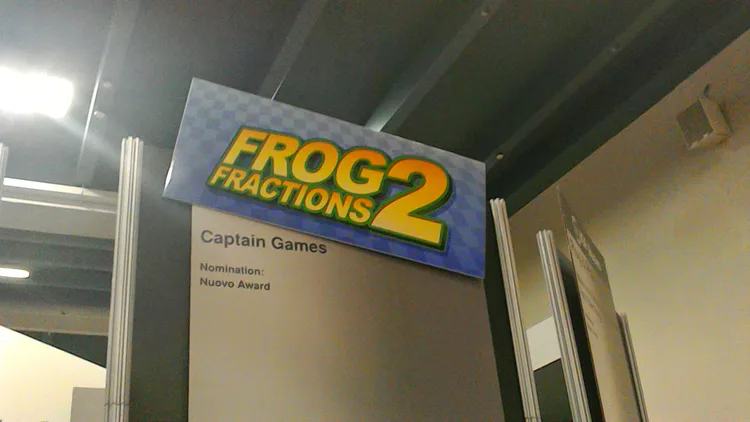
I’m not sure if Killer Queen was actually part of the IGF Pavilion, but there were a pair of Killer Queen arcade cabinets located on or just next to it. The team-based action-strategy game can accommodate up to 10 players per cabinet, and there was a constant cluster of players and observers around each one. The game’s allure is partly due to the novelty value of the cabinet, which is nifty in itself and is also the only way you can play the game; but the game is popular because it’s incredibly well designed and full of twists and tidbits that keep it engaging and replayable. One example of this is the presence of 3 win conditions.
{% pullquote Killer Queen Arcade %}
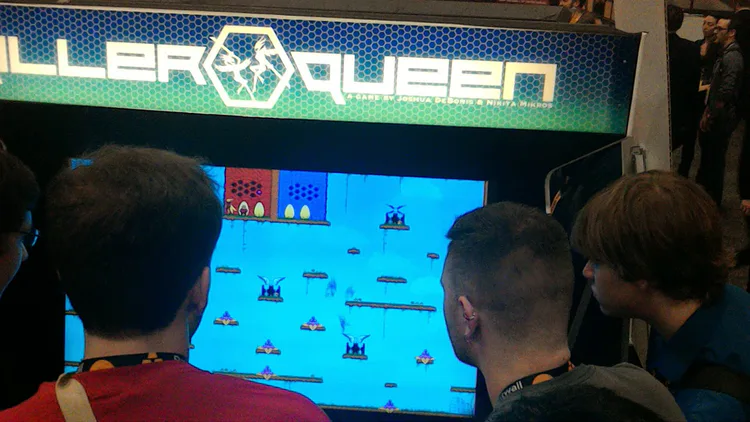
While loitering about the pavilion, I heard snippets of conversations ranging from fascinating to mundane. I insinuated myself into one conversation that struck me as extra-interesting. The developer of one of the IGF games (I won’t mention here who or which) had become aware of an unauthorized foreign-language translation of his game’s text being circulated online. The developer was looking for a speaker of the language to help him contact the translator and, rather than asking them to stop, seeing if they would grant the rights to use the text as the game’s official translation for that langauge. Ah, the vagaries of international copyright law!
You run into a lot of different people at GDC. I ran into indie developer (and recent interview subject) James Earl Cox III at the IGF Pavilion, who was at the conference as part of the IGDA Scholarships program.
{% pullquote James Earl Cox III with Joe Cox and Denver Coulson %}

My next attack of incoherent fanboyishness struck when I passed by the 80 Days booth and a fellow asked me if I’d played the game. Had I played it? Had I played it! I was quite familiar with the game, which was nominated for Excellence in Design, Excellence in Narrative, and the Seumas McNally Grand Prize. 80 Days is one of the best, most accessible, most replayable works of interactive fiction I’ve ever played (and I’ve played quite a few). It’s also my second most played game so far this year, and I told him so. That’s when I recognized him as Jon Ingold, co-founder of Inkle Studios, the team that’s spearheading the current commercial interactive fiction renaissance, and author of such IF classics as Fail-Safe and All Roads.
I knew I had a bunch of questions I wanted to ask him, but I couldn’t think of a single one just then. I think I told him how much I liked his games a few times. Before he was called away for a scheduled interview, however, he offered to show me a bit of the upcoming Sorcery 3. Having adored the first two installments, I was thrilled to see whatever he would show me. I plan to cover this game in a future article, as well as what I learned from Jon’s talk “Adventures in Text”, which I attended about an hour later.
The IGF Awards
I was pretty excited to be going to the IGF Awards ceremony, though I was not deeply invested in any of the finalists other than 80 Days. I figured 80 Days would probably win the narrative award, and I felt pretty strongly that it could even take the top prize, even though it was up against The Talos Principle, which was great.
I was far less certain about any of the other categories. Every one of the finalists that I had played were great and the ones I hadn’t yet played looked amazing.
The ceremony itself was packed and flashy, with giant screens showing the action taking place on the distant stage. There were jokes and there was charisma, but none of it was nearly as memorable as the thrill and surprise on the faces of each of the winners as they took the stage to accept their awards. The winners were uniformly gracious and humble and charming. Every one of them deserved their awards (though I admit to being initially surprised that Outer Wilds won the Seumas McNally over 80 Days or The Talos Principle). For the record, here’s a handy chart of the winning games:
Award | Winner
Grand Prize | Outer Wilds
Excellence in Visual Arts | Metamorphabet
Excellence in Design | Outer Wilds
Excellence in Audio | Ephemerid
Excellence in Narrative | 80 Days
Nuovo Award | Tetrageddon Games
Student Award | Close Your
Audience Award | This War of Mine
I admit that I, as part of a large Katamari of indie-type folk, exited the auditorium at the end of the IGF Awards. I didn’t mind missing the GDC Choice Awards that followed, even if Double Fine’s Tim Schafer was taking the stage as I made my way out. After all, I had a party to attend.
{% pullquote The Wild Rumpus flyer %}

Hunt the Wild Rumpus
The fabled event known as The Wild Rumpus, which is officially named That Venus Patrol and Wild Rumpus Party, lived up to its reputation as a harassment-free dance party and a great time. It was quite loud and full of flashing lights, so be prepared for that if you go to one. The atmosphere was like a mix of nightclub and underground art museum. DJ’s pumped chiptunes and techno music while a full dancefloor surged to the beat and surreal videogame scenes were projected on the wall. Around and upstairs from the dancefloor were dark corridors and dimly-lit rooms filled with people and videogame installations. At least 3 bars had been set up, as had a really cool zine stand. There was even a coat check room where I could leave my backpack for the duration of the party.
A number of indie games were available to play projected on various walls. Bennett Foddy’s Speed Chess, a weird multiplayer chess game played in 4-second bursts, was there. The exceptional one-keyboard, as-many-players-as-can-fit party game was on display and responsible for regular bursts of laughter throughout the night. The adorable Stellar Smooch was being shown; its usual control scheme of tapping a touchscreen was replaced by players bumping into a painted children’s rubber bouncy toy that was suspended like a big punching bag from the ceiling.
My favorite part of The Wild Rumpus was the definitely the Bernband installation. The beautiful sci-fi city explorer by Tom van den Boogaart (another previous interviewee) was enshrined in its own room, which had been decked out with visuals recreated from the game. Bernband was projected on the wall as the current player sat in a chair that had been adorned with big, grey arms like the ones you always see before you in the game’s first-person view. It was wonderful! Unfortunately, Tom could not be there at GDC this year, but I bet it would have blown his mind.
{% pullquote The Bernband room at the Wild Rumpus %}
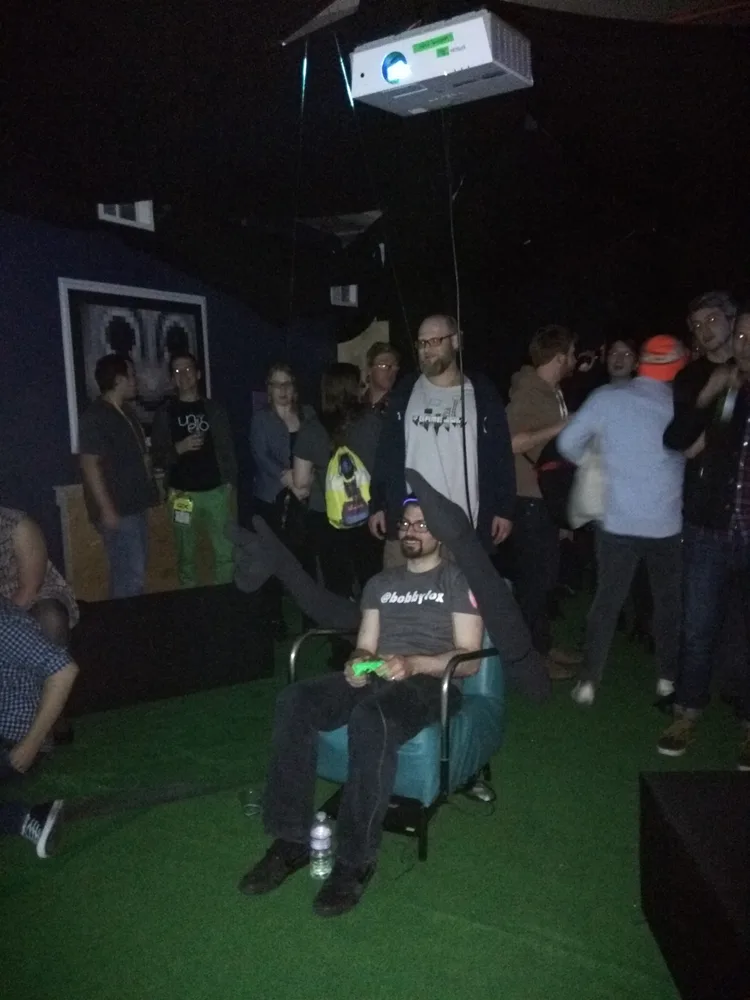
After the Party
I stayed at the Rumpus until my feet began to protest almost audibly and my vision blurred beyond a reasonable amount. As I rode in an Uber car back to my hotel, I reflected on all the incredible games I had seen and the cool people I had met. I also thought about how quickly the day had seemed to fly by, and how much had been packed into it. On the other hand, my body felt as tired as if I’d already been there for a week.
I honestly can’t tell you the objective quality of the bed in my hotel room, but it felt like the most profoundly comfortable one I’d ever encountered. My god, did my feet hurt. I drifted off easily, thinking of how cool Lost Levels was going to be the next day. So many indies and alt games people in one place! Where was it, again? I knew it didn’t actually take place in the Moscone Center, but was set up nearby. I’d have to check the website in the morning. I was too jetlagged and muddle-headed to figure it out at the moment. I’d have to check the time, too; I couldn’t remember when it started. When it started… Something nagged at me, but I was too tired to process it, and then I was lost to sleep.
Join me for Part 2 of my GDC memoir tomorrow!
Update: Read Part 2 here!
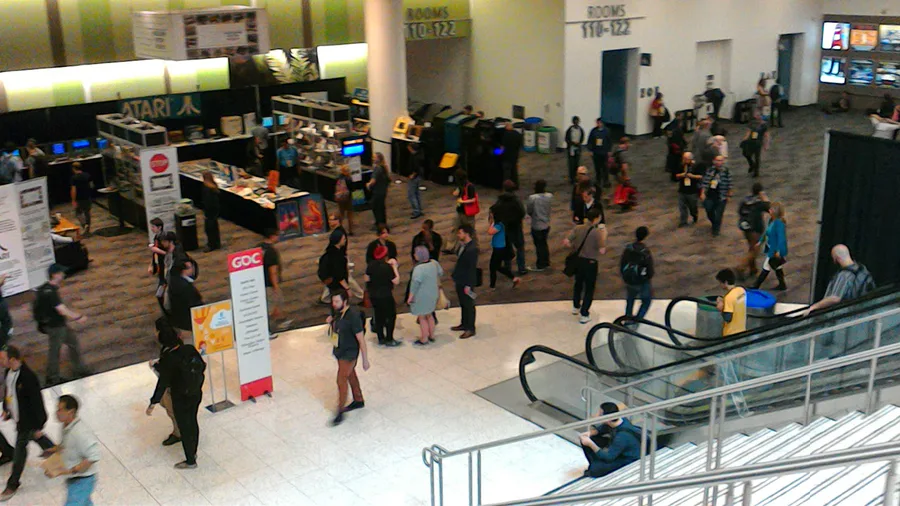
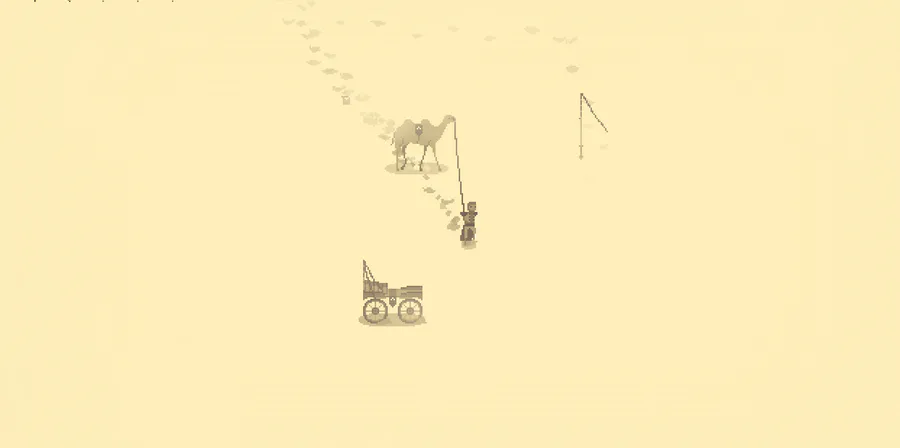
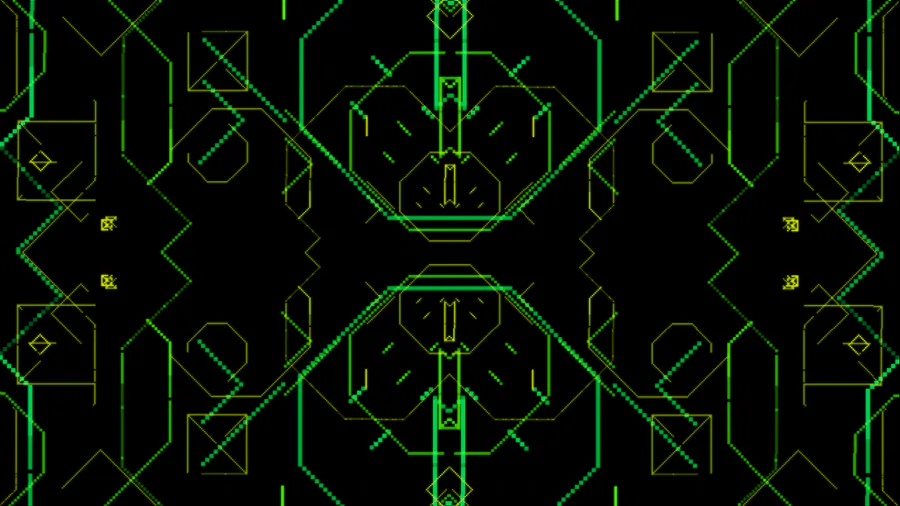
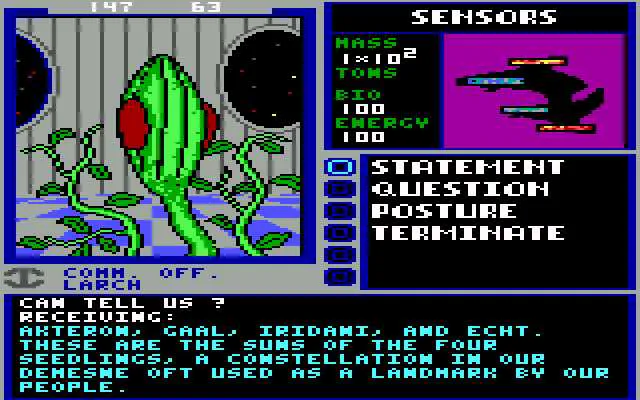



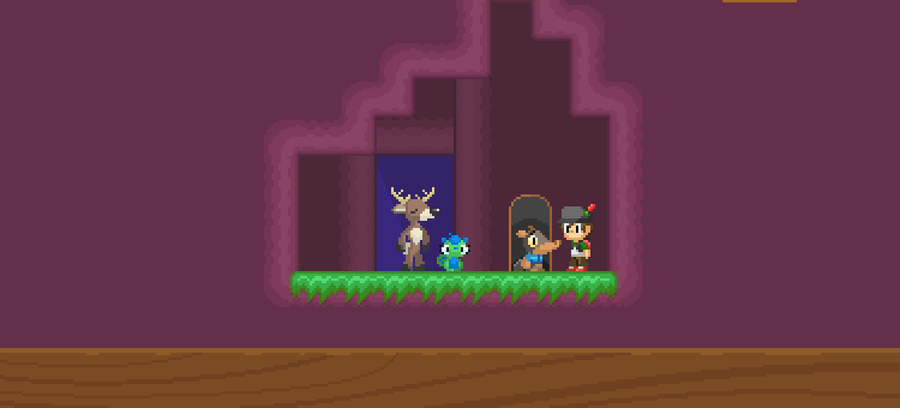


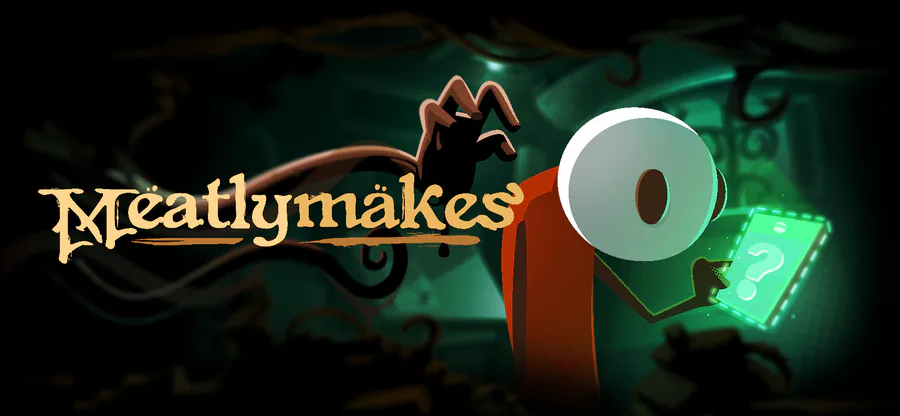
2 comments